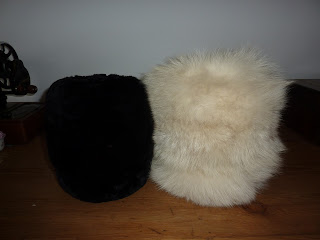Some years later, after purchasing this vintage/antique muff, I gave the cape and the muff to a friend.
When friends gave me a vintage 1950's/1960's polar fox stole (without head) I immediately knew I wanted to turn it into a white muff. To go with this jacket and hat! Although my trusty black muff looks quite well as well!
As I have always been happy with how my first muff turned out I used the same description which I found in 2006 floating somewhere on the internet.
"...I have some muffs from this period and they are made thus:
Make 2 tubes of muslin cut about 13/14" x21", one should be about 2" less
than the other.Stitch one end together and make a 3/4" chenille for elastic,
and fill with feathers (or you may opt for heavy poly quilt filler)Stitch
the open end; make a chenille as in the other end .
(you may wish to sew satin facings of about 6" oh each end of the inner bag
as the lining might show.
Cut and thread 2 pieces of elastic about 10" in the ends
Make a second (well, third) tube of fur, chenille, or other fabric of your
choice about 1" less than the tube already assembled, and cover the inner
piece.
Add a handle on one end, of silk braid or rope.
Embellish with tassels to taste..."
I couldn't find the original source anymore but wanted to share this with you anyway because I found it really helpful. If you wrote this or you know who wrote this please let me know. I would be very happy to give you credit!
I did make some small changes when I made my second muff. For the first I used heavy poly quilt filler. To make this muff a little more historically accurate I used kapoc, a natural plant fibre. Which was oftend used in pillows and muffs. It has the added bonus that is not only more historically accurate but also warmer!
The tubes where made from scraps of white cotton. The invisible one is striped, the visible one a nice satin weave.
I also decided to add a pocket. I had no idea how to do it and I am really bad at just winging it. So I decided to call in the cavalry in the shape of a workbook by Historical Sewing, the Faux Fur Muff pattern. I was very easy to follow and had very clear instructions, if you are thinking of make your own muff this would be a wise investment.
After putting the lining together it looked like this, in front of the lining is the polar fox fur.
You see that the tube has been filled but not sewn shut yet. Note: make sure you put in enough filling so that it can stand on a side without collapsing.
Why the pocket in the muff, you might ask. It can be used for a wallet or a mobile phone but I use it to hold a hand/muff warmer.
My very small collection of vintage and antique muff warmers (small hot water bottles).
Unfortunately only one of them still works! The copper muff warmer leaks and the antique pewter muff warmer doesn't open anymore. And as hot water is in short supply at most of my Victorian themed events, I cheat and use a modern zippo handwarmer, which stays warm for 12 hours. This type of handwarmer was invented in 1923.
Not just hot water bottles were used in the Victorian and Edwardianera but also small charcoal burners, like these:
Source: https://marketlavingtonmuseum.
Visit for more information and pictures.
Source: http://www.homethingspast.com
Interesting read.
Source: https://www.etsy.com/
Source: https://www.etsy.com/
Both are still available!
So Ladies no need for cold hands, let's keep them warm in style!

















No comments:
Post a Comment